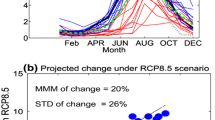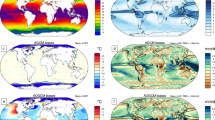Abstract
In this study, we investigate and quantify different contributors to inter-model differences in regional precipitation projections among CMIP5 climate models. Contributors to the spread are very contrasted between land and ocean. While circulation changes dominate the spread over oceans and continental coasts, thermodynamic changes associated with water vapor increase dominate over inland regions. The inter-model spread in the dynamic component is associated with the change in atmospheric radiative cooling with warming, which largely relates to atmospheric cloud radiative effects. Differences in the thermodynamic component result from the differences in the change in surface evaporation that is explained by decreases in surface humidity and limited surface water availability over land. Secondary contributions to the inter-model spread in thermodynamic and dynamic components result respectively from present-day climatology (owing to the Clausius–Clapeyron scaling) and from the shape of the vertical velocity profile associated with changes in surface temperature gradients. Advancing the physical understanding of the cloud-circulation and precipitation-evaporation couplings and improving their representation in climate models may stand the best chance to reduce uncertainty in regional precipitation projections.











Similar content being viewed by others
Notes
Fifth Phase of the Coupled Models Inter-comparison Project.
References
Allen MR, Ingram WJ (2002) Constraints on future changes in climate and the hydrologic cycle. Nature 419:224–232
Andrews T, Forster PM, Boucher O, Bellouin N, Jones A (2010) Precipitation, radiative forcing and global temperature change. Geophys Res Lett 37:14701
Back LE, Bretherthon CS (2006) Geographic variability in the export of moist static energy and vertical motion profiles in the tropical pacific. Geophys Res Lett 33:L17810
Bony S, Bellon G, Klocke D, Sherwood S, Fermepin S, Denvil S (2013) Robust direct effect of carbon dioxide on tropical circulation and regional precipitation. Nat Geosci 6:447–451
Bony S, Stevens B, Frierson DMW, J C, Kageyama M, Pincus R, Shepherd TG, Sherwood SC, Siebesma AP, Sobel AH, Watanabe M, Webb MJ (2015) Clouds, circulation and climate sensitivity. Nat Geosci 8:261–268
Boucher O et al (2013) Climate change 2013: the physical science basis. In: Stocker TF et al (eds) Clouds and aerosols. Cambridge University Press, Cambridge, pp 571–657
Byrne MP, O’Gorman PA (2013) Link between land-ocean warming contrast and surface relative humidities in simulations whith coupled climate models. Geophys Res Lett 40:5223–5227
Chadwick R, Boutle I, Martin G (2013) Spatial patterns of precipitation change in CMIP5: why the rich dont get richer in the tropics. J Clim 26:3803–3822
Chadwick R, Good P, Andrews T, Martin G (2014) Surface warming patterns drive tropical rainfall pattern responses to CO2 forcing on all timescales. Geophys Res Lett 41:610–615
Chou C, Neelin JD, Chen CA, Tu JY (2009) Evaluating the rich-get-richer mechanism in tropical precipitation change under global warming. J Clim 22:1982–2005
Fasullo J (2012) A mechanism for land-ocean contrasts in global monsoon trends in a warming climate. Clim Dyn 39:1137–1147
Fermepin S, Bony S (2014) Influence of low-cloud radiative effects on tropical circulation and precipitation. J Adv Model Earth Syst 6:513–526
Greve P, Orlowsky B, Mueller B, Sheffield J, Reichstein M, Seneviratne SI (2014) Global assessment of trends in wetting and drying over land. Nat Geosci 7:716–721
He J, Soden BJ (2015) Anthropogenic weakening of the tropical circulation: the relative roles of direct CO2 forcing and sea surface temperature change. J Clim press 28:8728–8742
He J, Soden BJ, Kirtman B (2014) The robustness of the atmospheric circulation and precipitation response to future anthropogenic surface warming. Geophys Res Lett 41:2614–2622
Held IM, Soden BJ (2006) Robust responses of the hydrological cycle to global warming. J Clim 19:5686–5699
Huang P, Xie SP, Huang G, Huang R (2013) Patterns of the seasonal response of tropical rainfall to global warming. Nat Geosci 6:357–361
Kent C, Chadwick R, Rowell DP (2015) Understanding uncertainties in future projections of regional precipitation. J Clim 28:4390–4413
Knutson T, Manabe S (1995) Time-mean response over the tropical pacific to increased CO2 in a coupled ocean-atmosphere model. J Clim 8:2181–2199
Lambert FH, Allen MR (2009) Are changes in global precipitation constrained by the tropospheric energy budget. J Clim 22:499–517
Lindzen RS, Nigam S (1987) On the role of the sea surface temperature gradients in forcing the low-level winds and convergence in the tropics. J Atmos Sci 44:2418–2436
Liu Z, Vavrus S, He F, Wen N, Zhong Y (2005) Rethinking tropical ocean response to global warming: the enhanced equatorial warming. J Clim 18:4684–4700
Lorenz DJ, DeWeaver ET, Vimont DJ (2010) Evaporation change and global warming: the role of net radiation and relative humidity. J Geophys Res 115:D20118
Ma J, Xie SP (2013) Regional patterns of sea surface temperature change: a source of uncertainty in future projections of precipitation and atmospheric circulation. J Clim 26:2482–2501
Mitchell JFB, Wilson CA, Cunnington W (1987) On CO2 climate sensitivity and model dependence of results. Q J R Meteorol Soc 113:293–322
Muller CJ, O’Gorman PA (2011) An energetic perspective on the regional response of precipitation to climate change. Nat Clim Change 1:266–271
O’Gorman PA, Muller CJ (2010) How closely do changes in surface and column water vapor follow ClausiusClapeyron scaling in climate change simulations? Environ Res Lett 5:025207
O’Gorman PA, Allan RP, Byrne MP, Previdi M (2012) Energetic constraints on precipitation under climate change. Surv Geophys 33:585–608
Oueslati B, Bellon G (2013) Tropical precipitation regimes and mechanisms of regime transitions: contrasting two aquaplanet general circulation models. Clim Dyn 40:2345–2358
Previdi M (2010) Radiative feedbacks on global precipitation. Environ Res Lett 5:025211
Richter I, Xie SP (2008) Muted precipitation increase in global warming simulations: a surface evaporation perspective. J Geophys Res 113:D24118
Sherwood SC, Ingram W, Tsushima Y, Satoh M, Roberts M, Vidale PL, O’Gorman PA (2010) Relative humidity changes in a warmer climate. J Geophys Res 115:D09104
Sherwood SC, Bony S, Boucher O, Bretherton C, Forster PM, Gregory JM, Stevens B (2015) Adjustments in the forcing-feedback framework for understanding climate change. Bull Am Meteorol Soc 96:217–228
Stephens G, Ellis TD (2008) Controls of global-mean precipitation increases in global warming GCM experiments. J Clim 21:6141–6155
Stevens B, Bony S (2013) What are climate models missing? Science 340:1053–1054
Stevens B, Bony S, Webb M (2012) Clouds on-off klimate intercomparison experiment (COOKIE). http://www.euclipse.eu/wp4/wp4.html
Taylor KE, Stouffer RJ, Meehl GAA (2012) A summary of the CMIP5 experiment design. Bull Am Meteorol Soc 93:485–498
Voigt A, Shaw TA (2015) Circulation response to warming shaped by radiative changes of clouds and water vapor. Nat Geosci 8:102–106
Watanabe M, Shiogama H, Yoshimori M, Ogura T, Yokohata T, Okamoto H, Emori S, Kimoto M (2012) Fast and slow timescales in the tropical low-cloud response to increasing CO2 in two climate models. Clim Dyn 39:1627–1641
Xie SP, Deser C, Vecchi GA, Ma J, Teng H, Wittenberg AT (2010) Global warming pattern formation: sea surface temperature and rainfall. J Clim 23:966–986
Acknowledgments
This work was supported by the ClimaConf (ANR-10-CEPL-003) and the Isotropic (ANR-12-BS06-001) ANR projects. We acknowledge the World Climate Research Programme’s Working Group on Coupled Modelling, which is responsible for CMIP, and we thank the climate modeling groups (listed in Table 1 of this paper) for producing and making available their model output. We also thank the two anonymous reviewers for their helpful comments.
Author information
Authors and Affiliations
Corresponding author
Rights and permissions
About this article
Cite this article
Oueslati, B., Bony, S., Risi, C. et al. Interpreting the inter-model spread in regional precipitation projections in the tropics: role of surface evaporation and cloud radiative effects. Clim Dyn 47, 2801–2815 (2016). https://doi.org/10.1007/s00382-016-2998-6
Received:
Accepted:
Published:
Issue Date:
DOI: https://doi.org/10.1007/s00382-016-2998-6




